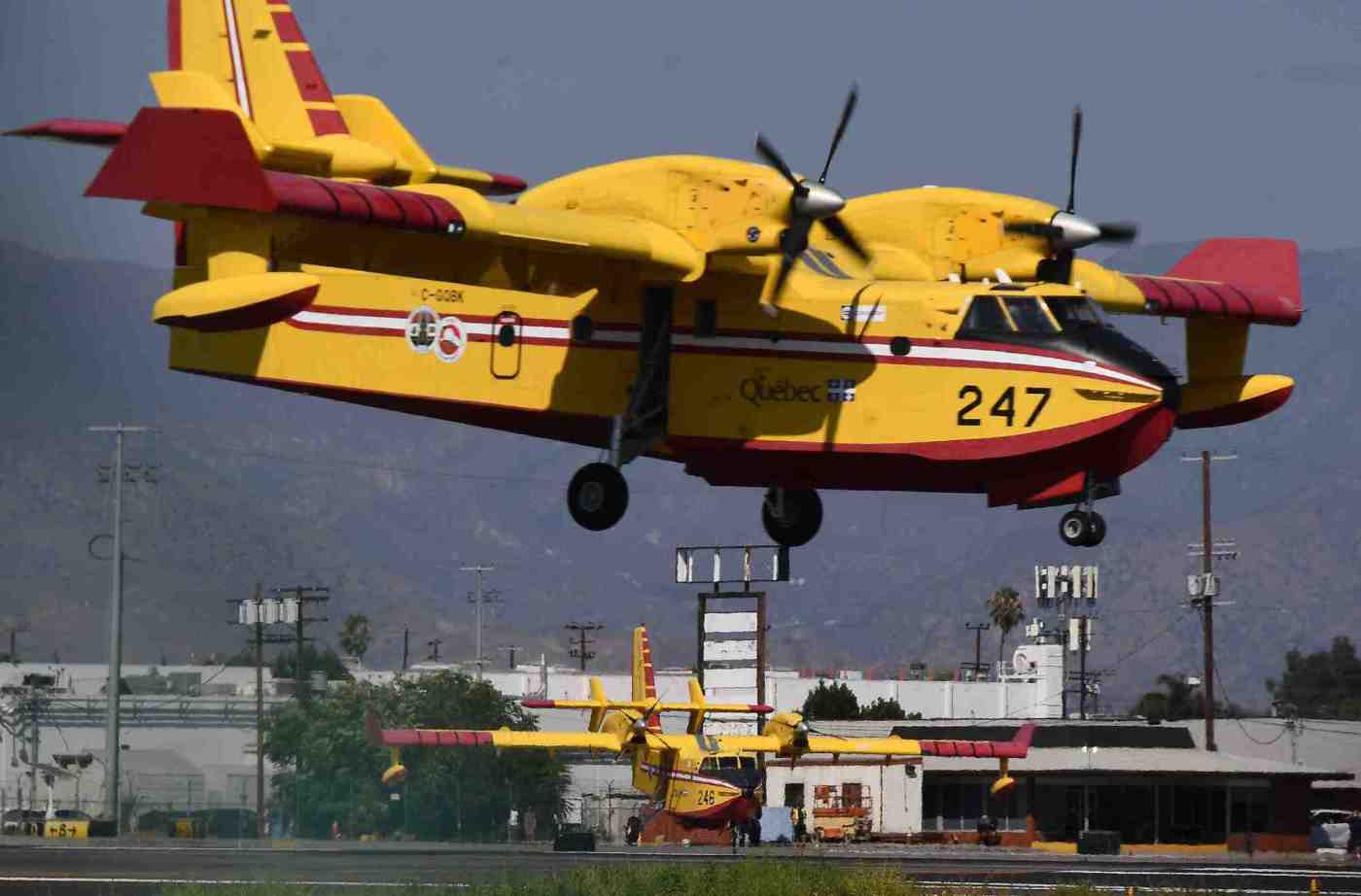They are more than 65 feet long, with a wingspan of roughly 93 feet; inside, only a pilot and co-pilot sit. The power and purpose of these planes come from their tanks, which hold 1,600 gallons of water.
They are the CL-415 Super Scoopers, on loan from Quebec, as part of an ongoing partnership between the Canadian province and Los Angeles. The two planes are sent to assist the Los Angeles County Fire Department with aerial firefighting efforts each year.
“We carry out 1,600 gallons of water and we scoop that 1,600 gallons in about 10 to 15 seconds depending on the speed and where we are,” said Pascal Duclos, chief pilot at Quebec’s transport ministry.
The tanks, which sit on either side of the center of the plane and extend underneath, scoop up water, dropping it every two to three minutes. They can operate for two and a half hours before needing to be refueled.
The two Super Scoopers touched down in Los Angeles County from Quebec, with pilots and technicians, and are ready for use. They will be kept at the Van Nuys Airport.
The county fire department displayed the planes and other aircraft at the Van Nuys Airport on Friday, Sept. 5 as a part of the aircraft media day.
The annual partnership between Los Angeles and Quebec began in 1994. The planes fly over to Los Angeles with a pilot, co-pilot and technician and work on any fire that meets the criteria for their use. While the inside of the plane is expansive, when the Super Scoopers fly firefighting missions, just a pilot and co-pilot are inside. The rest of the plane remains empty, its size necessary to support the large tanks of water.
The Super Scoopers were deployed during the Palisades and Eaton fires, which burned during one of the most “memorable” fire seasons in the history of the partnership, with fall and winter fires in 2024 and 2025 creating challenging environments where pilots faced “hazardous flying conditions,” and had to battle “extraordinary” winds as well as heat, smoke and flames, noted Anna-Catherine Briand-Fortin, Acting Delegate of Quebec in Los Angeles.
“The intensity of the maneuvers required rigorous daily maintenance to ensure the optimal performance of the aircraft,” Briand-Fortin said. “More than 40 pilots and technicians were deployed on a rotating basis for a mission that lasted nearly six months.”
Duclos, the chief pilot from Quebec, said he looks forward to flying in Los Angeles. There are key differences between flying in Canada versus California, where there are more aircraft to coordinate with, terrain is different and the pilots work with Los Angeles County on many aspects, from coordinating water drops to getting clearance to fly.
The annual deployment of the Super Scoopers to Los Angeles is important in ensuring Los Angeles County has sufficient aerial firefighting resources, Los Angeles County Fire Department Chief Anthony Marrone said. As the fall season begins, the county has not seen significant rainfall across the past year, which can contribute to fire risk.
“As a result, live fuel moisture has dropped to critical levels, making the vegetation throughout Los Angeles County potent for wildfires,” Marrone said. “This is why we must remain vigilant and educate everyone on the importance of being prepared for the Santa Ana winds that will arrive in the fall because they have the potential to fuel fast-moving wildfires.”
Alongside the Super Scoopers, the department displayed other aircraft in its fleet on the Van Nuys tarmac, including a S-70 Firehawk helicopter, Coulson CU-47 Chinook helitanker and Bell 412HP helicopter. These aircraft are kept at other locations, including in Pacoima and at the department’s Camp 8 in Malibu.
In aerial firefighting, situations are very dynamic and forward thinking and trust between members of crews is important, said Benjamin Berman, recently appointed chief pilot of the Los Angeles County Fire Department.
“It’s a constantly changing environment, it’s constantly dynamic and we have to be three or four steps ahead of the aircraft,” Berman said. “We always have to have an exit plan, meaning if I’m going to go into this maneuver and I’m going to do an uphill drop or I’m going to go into the slot canyon, I’ve got to be able to approach it and be able to attack it with, worst case scenario, I lose an engine or I have some type of emergency, I have a way out. And so we’re constantly looking at how to do it, how to do it safely and what’s our exit plan in case things go wrong.”
Berman, an experienced pilot who previously worked with Cal Fire and the Coast Guard, emphasized the importance of communication, as these aircrafts serve different missions, from rescuing a person with the hoisting capabilities, to dropping water or dropping off crews to work directly on a fire.
“We have to get to know each other, know each other’s verbal communication cues, our the tone of voice. All of those things are extremely important because when we’re flying, I don’t get to see your visual communication mannerisms. I can only hear you and I can hear your tone of voice and by getting to know you, I know, hey, that’s important or that’s something that we need to deal with right now,” he said.





